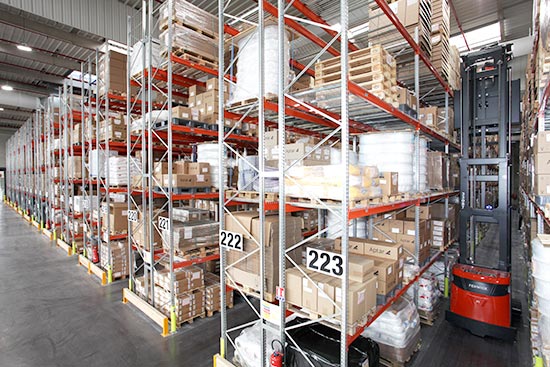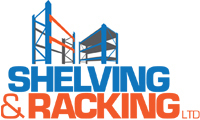What is VNA Pallet Racking?
VNA pallet racking, or very narrow aisle racking, is great for maximising your warehouse space. By stacking pallets closely together, it’s a system that allows easy access to all pallets while utilising every bit of available space. In warehouses, making every square metre profitable is crucial. VNA pallet racking achieves this by using narrow aisles and stacking pallets high. Call us to discuss your requirements on 0800 612 3210 or send us an enquiry.
VNA pallet racking stands out as one of our best options for making the most of space when storing pallets. Its narrow aisles allow more pallets per m2 compared to standard pallet racking. Very narrow aisles push this efficiency to an even greater extent. See the typical aisle widths for pallet racking below.
Standard or wide aisle pallet racking:
• Aisle width – 3.5m to 4m
• FLT – Counterbalance truck
• Can be as narrow as 2.5m for access via reach truck
Narrow aisle pallet racking:
• Aisle width – 1.8m to 2.3m
• FLT – Specialist narrow aisle truck
VNA pallet racking:
• Aisle width – 1.5m to 1.6m
• FLT – Rail or wire-guided VNA truck
Why Use VNA Pallet Racking?
VNA pallet racking achieves an average of 55% space utilisation. This means an average of 55% warehouse space used for storage and 45% for aisles. In contrast, standard (wide aisle) pallet racking achieves 40% space utilisation, while narrow aisle pallet racking achieves 50%.
Although a 5% increase in space utilisation may appear small, the impact becomes clear when you crunch the numbers. A 5% expansion in pallet space translates to a notable revenue boost. For larger warehouse operations, this increase is significant.
How Safe is VNA Pallet Racking?
VNA pallet racking is typically higher than standard APR, enabling loading and unloading from significant heights. What’s more, the specialised trucks used with VNA pallet racking are very efficient and designed for safe operation at these heights. Various options are available for VNA pallet racking trucks. Including a man-up truck, which allows the operator to ride with the pallet to the top, improving visibility. In addition, backstops can be installed to prevent pallets from accidentally being pushed off the rear racks and anti-collapse mesh can be added to secure the goods on the pallets.
Rail Guided VNA Pallet Racking
In this system, forklifts need rollers as guides on their sides. Metal rails are then installed along the sides of the working aisle to guide the truck along it. Therefore, ensuring it stays on a straight course. The guide rails can be high or low depending on the storage needs of the first level of the pallet racking.
Wire Guided VNA Pallet Racking
The inductive or wire-guided system uses sensors and a cable circuit under the floor to guide the forklift.
This cable or wire under the floor generates a small electromagnetic field that connects to the sensors built into the forklifts ensuring that the forklift stays on the designated circuit without any lateral deviations
This system ensures maximum safety and automates forklift movements in the aisle. Install the wire circuit after setting up the VNA pallet racking.
Do I need a P&Ds for my VNA Pallet Racking?
VNA pallet racking trucks are highly efficient within the racking system but slow down when moving pallets outside this area, such as to an external doorway. For these tasks, a counterbalance truck is faster, but it can’t place pallets into the VNA system. The common solution is to use pick and deposit stations (P&Ds), located at the entrance of the VNA pallet racking. The counterbalance truck drops pallets at the P&Ds, and the VNA truck then picks them up to store them. There are two types of P&Ds: castellated, where every other racking row is extended for better access, and cantilevered, placed at the end of each row, allowing both trucks to work efficiently in a two-directional motion.
When deciding between cantilever and castellated P&Ds, consider the pattern in which pallets are picked and transported during delivery. Since pallets are not equal on all sides, they need to be correctly angled on the P&Ds to align with the non-turning guided VNA truck. Narrow aisle racking bays are typically 1100mm wide, suitable for both UK and EU pallets without decking. However, UK pallets measure 1200mm x 1000mm, and EU pallets measure 1200mm x 800mm, so the 1200mm side should always rest on the 1100mm beams when placing them onto the pallet racking.
Advantages of VNA Pallet Racking
Effective Space Utilisation – maximising both floor and vertical space can significantly increase storage capacity, potentially by up to 50% or more for some businesses.
Increased Productivity – using faster specialised trucks, VNA pallet racking ensures that the picking and loading process is both safe and efficient. Stock is easy to find with 100% direct access, even at heights, using the specialised trucks.
Increased Safety – advanced handling features on narrow aisle trucks, including “man-up” capabilities, enhance the safety of load handling for your staff.
Reduced Damage – guiding the forklifts down the aisle without manual steering greatly reduces the risk of pallet racking damage, minimising the chance of collapses.
Disadvantages of VNA Pallet Racking
Lower Flexibility – all pallets need to be the same size to get the most from the VNA pallet racking.
Requirement for Specialised Equipment – a narrow aisle trucks is necessary to allow for manoeuvring between the narrow aisles. These specialised trucks are not functional outside of the working aisles.
Fitting of Guide Rails or Wire – a guidance system at floor level is necessary to ensure the precise positioning of the forklift trucks.
The main downside is that VNA pallet racking requires installation on a perfectly flat concrete floor. It is essential that the warehouse floor meets the required specifications including a super flat surface. VNA pallet racking is normally higher than standard pallet racking, with an uneven floor the trucks can tilt and knock the pallet racking at height which is highly dangerous.
If you have weighed up the pros and cons and would like to find out more about VNA pallet racking for your business, you can contact our sales team on 0800 612 3210 to discuss your requirements.


Cart